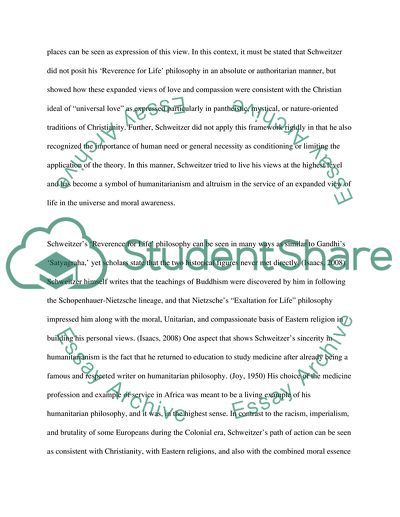Cite this document
(Albert Schwetzer and His Works Research Paper Example | Topics and Well Written Essays - 2500 words, n.d.)
Albert Schwetzer and His Works Research Paper Example | Topics and Well Written Essays - 2500 words. Retrieved from https://studentshare.org/biographies/1752204-determine-whether-schweitzer-consistently-applied-his-reverence-for-life-philosophy-to-plants-and-animals-he-talked-the-talk-but-did-he-walk-the-walk-he-said-reverence-for-life-applied-to-all-of-life-not-just-human-life
Albert Schwetzer and His Works Research Paper Example | Topics and Well Written Essays - 2500 words. Retrieved from https://studentshare.org/biographies/1752204-determine-whether-schweitzer-consistently-applied-his-reverence-for-life-philosophy-to-plants-and-animals-he-talked-the-talk-but-did-he-walk-the-walk-he-said-reverence-for-life-applied-to-all-of-life-not-just-human-life
(Albert Schwetzer and His Works Research Paper Example | Topics and Well Written Essays - 2500 Words)
Albert Schwetzer and His Works Research Paper Example | Topics and Well Written Essays - 2500 Words. https://studentshare.org/biographies/1752204-determine-whether-schweitzer-consistently-applied-his-reverence-for-life-philosophy-to-plants-and-animals-he-talked-the-talk-but-did-he-walk-the-walk-he-said-reverence-for-life-applied-to-all-of-life-not-just-human-life.
Albert Schwetzer and His Works Research Paper Example | Topics and Well Written Essays - 2500 Words. https://studentshare.org/biographies/1752204-determine-whether-schweitzer-consistently-applied-his-reverence-for-life-philosophy-to-plants-and-animals-he-talked-the-talk-but-did-he-walk-the-walk-he-said-reverence-for-life-applied-to-all-of-life-not-just-human-life.
“Albert Schwetzer and His Works Research Paper Example | Topics and Well Written Essays - 2500 Words”, n.d. https://studentshare.org/biographies/1752204-determine-whether-schweitzer-consistently-applied-his-reverence-for-life-philosophy-to-plants-and-animals-he-talked-the-talk-but-did-he-walk-the-walk-he-said-reverence-for-life-applied-to-all-of-life-not-just-human-life.


